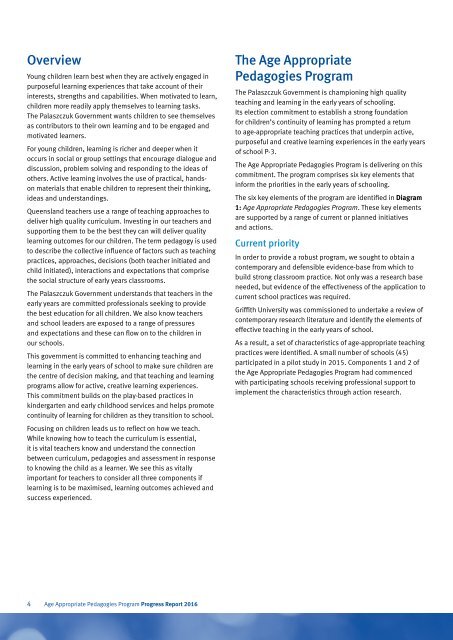Age Appropriate Pedagogies Program
aap-program-progress-report-2016
aap-program-progress-report-2016
You also want an ePaper? Increase the reach of your titles
YUMPU automatically turns print PDFs into web optimized ePapers that Google loves.
Overview<br />
Young children learn best when they are actively engaged in<br />
purposeful learning experiences that take account of their<br />
interests, strengths and capabilities. When motivated to learn,<br />
children more readily apply themselves to learning tasks.<br />
The Palaszczuk Government wants children to see themselves<br />
as contributors to their own learning and to be engaged and<br />
motivated learners.<br />
For young children, learning is richer and deeper when it<br />
occurs in social or group settings that encourage dialogue and<br />
discussion, problem solving and responding to the ideas of<br />
others. Active learning involves the use of practical, handson<br />
materials that enable children to represent their thinking,<br />
ideas and understandings.<br />
Queensland teachers use a range of teaching approaches to<br />
deliver high quality curriculum. Investing in our teachers and<br />
supporting them to be the best they can will deliver quality<br />
learning outcomes for our children. The term pedagogy is used<br />
to describe the collective influence of factors such as teaching<br />
practices, approaches, decisions (both teacher initiated and<br />
child initiated), interactions and expectations that comprise<br />
the social structure of early years classrooms.<br />
The Palaszczuk Government understands that teachers in the<br />
early years are committed professionals seeking to provide<br />
the best education for all children. We also know teachers<br />
and school leaders are exposed to a range of pressures<br />
and expectations and these can flow on to the children in<br />
our schools.<br />
This government is committed to enhancing teaching and<br />
learning in the early years of school to make sure children are<br />
the centre of decision making, and that teaching and learning<br />
programs allow for active, creative learning experiences.<br />
This commitment builds on the play-based practices in<br />
kindergarten and early childhood services and helps promote<br />
continuity of learning for children as they transition to school.<br />
Focusing on children leads us to reflect on how we teach.<br />
While knowing how to teach the curriculum is essential,<br />
it is vital teachers know and understand the connection<br />
between curriculum, pedagogies and assessment in response<br />
to knowing the child as a learner. We see this as vitally<br />
important for teachers to consider all three components if<br />
learning is to be maximised, learning outcomes achieved and<br />
success experienced.<br />
The <strong>Age</strong> <strong>Appropriate</strong><br />
<strong>Pedagogies</strong> <strong>Program</strong><br />
The Palaszczuk Government is championing high quality<br />
teaching and learning in the early years of schooling.<br />
Its election commitment to establish a strong foundation<br />
for children’s continuity of learning has prompted a return<br />
to age-appropriate teaching practices that underpin active,<br />
purposeful and creative learning experiences in the early years<br />
of school P-3.<br />
The <strong>Age</strong> <strong>Appropriate</strong> <strong>Pedagogies</strong> <strong>Program</strong> is delivering on this<br />
commitment. The program comprises six key elements that<br />
inform the priorities in the early years of schooling.<br />
The six key elements of the program are identified in Diagram<br />
1: <strong>Age</strong> <strong>Appropriate</strong> <strong>Pedagogies</strong> <strong>Program</strong>. These key elements<br />
are supported by a range of current or planned initiatives<br />
and actions.<br />
Current priority<br />
In order to provide a robust program, we sought to obtain a<br />
contemporary and defensible evidence-base from which to<br />
build strong classroom practice. Not only was a research base<br />
needed, but evidence of the effectiveness of the application to<br />
current school practices was required.<br />
Griffith University was commissioned to undertake a review of<br />
contemporary research literature and identify the elements of<br />
effective teaching in the early years of school.<br />
As a result, a set of characteristics of age-appropriate teaching<br />
practices were identified. A small number of schools (45)<br />
participated in a pilot study in 2015. Components 1 and 2 of<br />
the <strong>Age</strong> <strong>Appropriate</strong> <strong>Pedagogies</strong> <strong>Program</strong> had commenced<br />
with participating schools receiving professional support to<br />
implement the characteristics through action research.<br />
4 <strong>Age</strong> <strong>Appropriate</strong> <strong>Pedagogies</strong> <strong>Program</strong> Progress Report 2016


